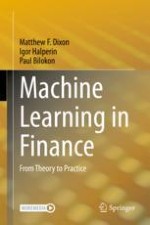2020 | OriginalPaper | Buchkapitel
4. Feedforward Neural Networks
verfasst von : Matthew F. Dixon, Igor Halperin, Paul Bilokon
Erschienen in: Machine Learning in Finance
Aktivieren Sie unsere intelligente Suche, um passende Fachinhalte oder Patente zu finden.
Wählen Sie Textabschnitte aus um mit Künstlicher Intelligenz passenden Patente zu finden. powered by
Markieren Sie Textabschnitte, um KI-gestützt weitere passende Inhalte zu finden. powered by
